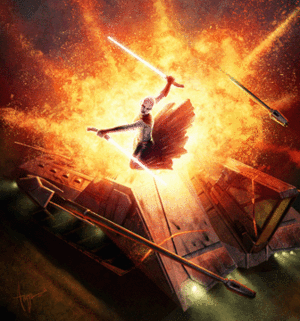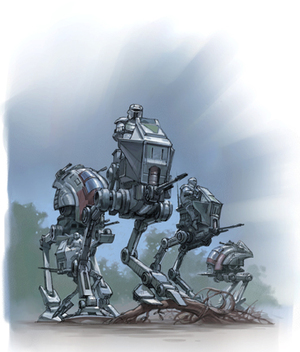
 If you’re looking for the excitement of the Star Wars universe in a tabletop game, there’s nothing better than Wizards of the Coast’s latest version of their Star Wars Roleplaying Game.
If you’re looking for the excitement of the Star Wars universe in a tabletop game, there’s nothing better than Wizards of the Coast’s latest version of their Star Wars Roleplaying Game.
The system uses D20′s classic architecture, which has been around since 2000. If you’ve played D&D anytime in the past decade plus, you already know how to play Star Wars. D20 is kinda like the Unix of roleplaying games — almost certainly the most tested and stable of all systems. It’s such a fan favorite that when Wizards announced it would be updating the system to reflect 4E sensibilities, D20 publisher Paizo elected to convert their products to their own flavor of D20 rather than make the transition.
At first glance the Star Wars RPG seems simple, with only five basic classes: Jedi, Noble, Scoundrel, Scout and Soldier. That, combined with the game’s friendly system and familiar setting might make you think it’s almost overly simplistic — not so. Actually, when you add in all the prestige classes, not to mention 17 races — including humans, Ewoks, Mon Calamari and Wookiee — you have many complex options for making characters. That, plus the absurd amount of background information, makes this game as complicated as you’d like it.
The big question I had when checking out the game was, how well did Wizards even out the classes? When you think about it, why would anyone want to play anything but a Jedi? The core mechanic that evens out the classes is the feats and powers system inherent in D20, the game’s underlying rule system. In the old days (there I go reminiscing like an old man!) the classes were unequal — a fighter was far tougher than a magic-user at lower levels, but was soon left by the wayside as the wizard became ultra powerful. Now, a 20th level rogue pretty much has as many abilities and powers as a 20th level sorcerer. The same applies to Star Wars, where the Jedi have no more feats than Smugglers or Ace Pilots, just different ones.

 One of the most expected changes was that the films’ characters were toned down a bit. Cinematic heroes who do everything right tend to make boring RPG characters. Case in point, the all-powerful Jedi needed to be taken down a notch. Mace Windu is described as a Jedi 8/Jedi Knight 6/Jedi Master 5 which makes him not much more powerful than some of the less remarkable Jedi. For instance, he’s only about twice as powerful as Aayla Secura, a relative no-name Jedi. In a way, this makes Jango Fett’s movie character a little less interesting. For a non-Jedi to be able to fight Jedi and win was pretty remarkable in the movies. With this system, such matchups will be far more common. While not very canonical, this mechanic is a clear necessity and the rules system handles it well.
One of the most expected changes was that the films’ characters were toned down a bit. Cinematic heroes who do everything right tend to make boring RPG characters. Case in point, the all-powerful Jedi needed to be taken down a notch. Mace Windu is described as a Jedi 8/Jedi Knight 6/Jedi Master 5 which makes him not much more powerful than some of the less remarkable Jedi. For instance, he’s only about twice as powerful as Aayla Secura, a relative no-name Jedi. In a way, this makes Jango Fett’s movie character a little less interesting. For a non-Jedi to be able to fight Jedi and win was pretty remarkable in the movies. With this system, such matchups will be far more common. While not very canonical, this mechanic is a clear necessity and the rules system handles it well.
The biggest departure from the D20 core rules I found was that of Destiny. At the GM’s option, characters could be given destinies… recall Luke Skywalker’s destiny to confront Darth Vader. So how does it work? They’re a lot like Fate points in Warhammer FRP or Edge in Shadowrun. You can burn a Destiny point to perform an impossible action or escape certain death — providing those actions bring the character closer to his or her destiny. GMs can also nudge characters toward their destiny by giving them bonuses when heading in the right direction and penalties when they get distracted. Fulfilling one’s destiny gives the character some permanent reward like a bump to an ability score — or, if the character dies fulfilling his destiny, his allies get bonuses to rolls for the next day.
I had the chance to check out four Star Wars RPG books:
Star Wars RPG Core Rulebook
This is one of the most neatly and clearly laid out rulebooks I’ve seen. It presents the game system simply and edits down a vast amount of background info into a clear and sensible summary of the game universe. Was a lot left out? Sure, but that’s what expansion books are for. What you get with this resource is everything you need to play the game collected in one book. A lot of games — such as its cousin, D&D 4E, can’t say the same.
The first chapters cover character creation, races, skills, feats and so forth. Then the book discusses the Force, a topic worthy of its own chapter. The following chapters provide lists of equipment and explains the combat system. Speaking of combat, the book comes with a table map and the system encourages use of the Star Wars miniatures Wizards sells. The book concludes with vehicles, droids, prestige classes and other stuff for the GM like a gazeteer of planets and tips on game mastering. As I mentioned, you really don’t need any book but this one, unless you need more background info — the ship book’s coverage of space travel and combat is invaluable.
Starships of the Galaxy
In a game that involves space battles and interstellar travel, the starship is king. This book teaches you everything you need to use ships in your Star Wars RPG campaign. Hyperspace travel, ship-related skills and feats, as well as ship combat.
I was happy to see that the book openly says that most players can pilot ships in combat. Many a space-based RPG session degenerated into boredom because only one PC could fly the ship. Of course, it doesn’t mean that the pilot is any good — think of Obi Wan in the opening sequence of Revenge of the Sith — he flew in combat, certainly, but he complained the whole time.
The bulk of the book consists of descriptions of almost any ship that you might encounter in the game, including archetypes that we saw in the movies. The Firespray-31 Patrol Craft? The basis for Boba Fett’s Slave I. Everything you’d ever want to know about Correllian frigates, Lambda-class shuttles, Mon Calamari cruisers and of course the classic TIE fighters and X-wings. The book even describes numerous types of ships that weren’t featured in the movies.

 The Clone Wars Campaign Guide
The Clone Wars Campaign Guide
This book provides background information for campaigns played in the Clone Wars era — Episodes I, II and III of the movies. Not content to simply parrot the movies, this resource also provides tons of back-story info — I’m not sure if it’s from novelizations or other resources, or was created for the game. It’s fascinating stuff either way and the detail will surely help game masters develop their campaigns.
There are new races, new skills, feats, and prestige classes, new droids and starships. As I mentioned earlier, the universe has a seemingly unlimited supply of new information to parcel out. However, the core value of this book is as a GM’s aid in running a campaign. Learn about the important planets and NPCs, and the forces of the two main sides in this galaxy-wide conflict.
The Force Unleashed Campaign Guide
This book provides information on running campaigns in the time between Episodes III and IV of the movies — the Dark Times when Obi Wan and Yoda are still exiled, and the Empire rules the galaxy. Darth Vader trains a secret apprentice to help him overthrow the Emperor, but eventually this apprentice turns on him and helps found the Rebel Alliance.
You get the same sort of stuff as the Clone Wars Campaign Guide — new races, new prestige classes, new ships and planets and villains. If you’re running a canonical Clone Wars campaign, you’ll need this book eventually because it covers he events after the end of the wars.

